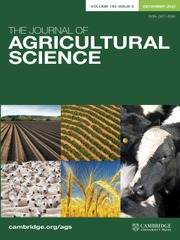Crossref Citations
This article has been cited by the following publications. This list is generated based on data provided by
Crossref.
Hervás, Gonzalo
Frutos, Pilar
Javier Giráldez, F
Mantecón, Ángel R
and
Álvarez Del Pino, Marı́a C
2003.
Effect of different doses of quebracho tannins extract on rumen fermentation in ewes.
Animal Feed Science and Technology,
Vol. 109,
Issue. 1-4,
p.
65.
Clauss, Marcus
Lason, Karin
Gehrke, Janin
Lechner-Doll, Matthias
Fickel, Jörns
Grune, Tilman
and
Jürgen Streich, W
2003.
Captive roe deer (Capreolus capreolus) select for low amounts of tannic acid but not quebracho: fluctuation of preferences and potential benefits.
Comparative Biochemistry and Physiology Part B: Biochemistry and Molecular Biology,
Vol. 136,
Issue. 2,
p.
369.
Hervás, G.
Pérez, V.
Giráldez, F.J.
Mantecón, A.R.
Almar, M.M.
and
Frutos, P.
2003.
Intoxication of Sheep with Quebracho Tannin Extract.
Journal of Comparative Pathology,
Vol. 129,
Issue. 1,
p.
44.
Ben Salem, H.
Makkar, H.P.S.
Nefzaoui, A.
Hassayoun, L.
and
Abidi, S.
2005.
Benefit from the association of small amounts of tannin-rich shrub foliage (Acacia cyanophylla Lindl.) with soya bean meal given as supplements to Barbarine sheep fed on oaten hay.
Animal Feed Science and Technology,
Vol. 122,
Issue. 1-2,
p.
173.
Dentinho, M.T.P.
Moreira, O.C.
Pereira, M.S.
and
Bessa, R.J.B.
2007.
The use of a tannin crude extract from Cistus ladanifer L. to protect soya-bean protein from degradation in the rumen.
Animal,
Vol. 1,
Issue. 5,
p.
645.
Osoro, K.
Mateos-Sanz, A.
Frutos, P.
García, U.
Ortega-Mora, L. M.
Ferreira, L. M. M.
Celaya, R.
and
Ferre, I.
2007.
Anthelmintic and nutritional effects of heather supplementation on Cashmere goats grazing perennial ryegrass-white clover pastures1.
Journal of Animal Science,
Vol. 85,
Issue. 3,
p.
861.
Yáñez-Ruiz, D.R.
and
Molina-Alcaide, E.
2007.
A comparative study of the effect of two-stage olive cake added to alfalfa on digestion and nitrogen losses in sheep and goats.
Animal,
Vol. 1,
Issue. 2,
p.
227.
Frutos, P.
Moreno-Gonzalo, J.
Hervás, G.
García, U.
Ferreira, L.M.M.
Celaya, R.
Toral, P.G.
Ortega-Mora, L.M.
Ferre, I.
and
Osoro, K.
2008.
Is the anthelmintic effect of heather supplementation to grazing goats always accompanied by anti-nutritional effects?.
Animal,
Vol. 2,
Issue. 10,
p.
1449.
Osoro, Koldo
Celaya, Rafael
Moreno-Gonzalo, Javier
Ferreira, Luis M.M.
García, Urcesino
Frutos, Pilar
Ortega-Mora, Luis M.
and
Ferre, Ignacio
2009.
Effects of Stocking Rate and Heather Supplementation on Gastrointestinal Nematode Infections and Host Performance in Naturally-Infected Cashmere Goats.
Rangeland Ecology & Management,
Vol. 62,
Issue. 2,
p.
127.
Krueger, W.K.
Gutierrez-Bañuelos, H.
Carstens, G.E.
Min, B.R.
Pinchak, W.E.
Gomez, R.R.
Anderson, R.C.
Krueger, N.A.
and
Forbes, T.D.A.
2010.
Effects of dietary tannin source on performance, feed efficiency, ruminal fermentation, and carcass and non-carcass traits in steers fed a high-grain diet.
Animal Feed Science and Technology,
Vol. 159,
Issue. 1-2,
p.
1.
Alipour, D.
and
Rouzbehan, Y.
2010.
Effects of several levels of extracted tannin from grape pomace on intestinal digestibility of soybean meal.
Livestock Science,
Vol. 128,
Issue. 1-3,
p.
87.
Mohammadab, T.
Chaji, M.
and
Tabatabaei, S.
2010.
The Effect of Tannic Acid on in vitro Gas Production and Rumen Fermentation of Sunflower Meal.
Journal of Animal and Veterinary Advances,
Vol. 9,
Issue. 2,
p.
277.
Mandaluniz, Nerea
Aldezabal, Arantza
and
Oregui, Luis M.
2011.
Diet selection of beef cattle on Atlantic grassland-heathland mosaic: Are heathers more preferred than expected?.
Livestock Science,
Vol. 138,
Issue. 1-3,
p.
49.
Fernández, H.T.
Catanese, F.
Puthod, G.
Distel, R.A.
and
Villalba, J.J.
2012.
Depression of rumen ammonia and blood urea by quebracho tannin-containing supplements fed after high-nitrogen diets with no evidence of self-regulation of tannin intake by sheep.
Small Ruminant Research,
Vol. 105,
Issue. 1-3,
p.
126.
Belachew, Z.
Yisehak, K.
Taye, T.
and
Janssens, G.P.J.
2013.
Chemical composition and in sacco ruminal degradation of tropical trees rich in condensed tannins.
Czech Journal of Animal Science,
Vol. 58,
Issue. 4,
p.
176.
Dentinho, M.T.P.
Belo, A.T.
and
Bessa, R.J.B.
2014.
Digestion, ruminal fermentation and microbial nitrogen supply in sheep fed soybean meal treated with Cistus ladanifer L. tannins.
Small Ruminant Research,
Vol. 119,
Issue. 1-3,
p.
57.
Jolazadeh, A.R.
Dehghan-banadaky, M.
and
Rezayazdi, K.
2015.
Effects of soybean meal treated with tannins extracted from pistachio hulls on performance, ruminal fermentation, blood metabolites and nutrient digestion of Holstein bulls.
Animal Feed Science and Technology,
Vol. 203,
Issue. ,
p.
33.
Ahnert, S.
Dickhoefer, U.
Schulz, F.
and
Susenbeth, A.
2015.
Influence of ruminal Quebracho tannin extract infusion on apparent nutrient digestibility, nitrogen balance, and urinary purine derivatives excretion in heifers.
Livestock Science,
Vol. 177,
Issue. ,
p.
63.
Castro‐Montoya, J.
Westreicher‐Kristen, E.
Henke, A.
Diaby, M.
Susenbeth, A.
and
Dickhoefer, U.
2018.
In vitro microbial protein synthesis, ruminal degradation and post‐ruminal digestibility of crude protein of dairy rations containing Quebracho tannin extract.
Journal of Animal Physiology and Animal Nutrition,
Vol. 102,
Issue. 1,
Ismael, Aya
Guevara-Oquendo, Victor H.
Refat, Basim
Zhang, Huihua
and
Yu, Peiqiang
2019.
Connection of inherent structure with nutrient profiles and bioavailability of different co-products and by-products after processing using advanced grading and vibrational molecular spectroscopy.
Critical Reviews in Food Science and Nutrition,
Vol. 59,
Issue. 17,
p.
2796.

